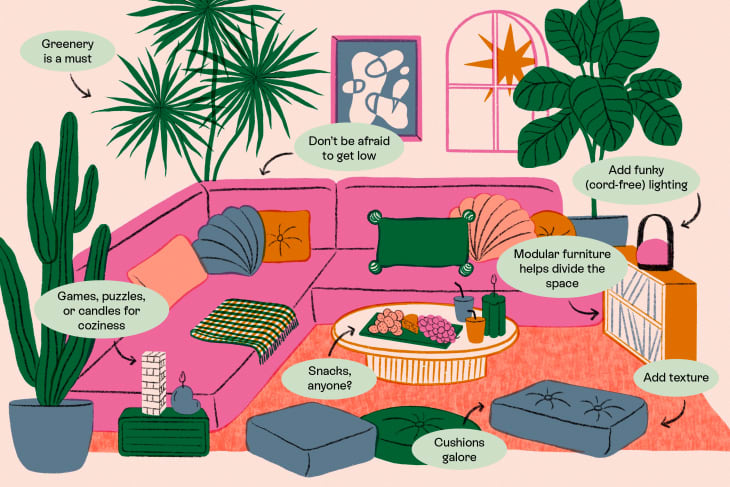How to Create a Conversation Pit in Your Home That’ll Amp Up Cozy, Friendly Vibes

Although minimalist Scandi-style is still cool to look at and live in, things have recently taken a turn for the textural, eclectic, and thrifted in the world of design. We’re living in a retro renaissance right now, which is why it’s as good a time as ever to return to one of the boldest living room trends of the past: conversation pits.
“They’re just so playful,” says Anna Stapor, who runs the Instagram account @conversation_pits. “The idea of changing levels within one room is just very novel to people. It’s fun to see images like that and imagine, ‘What if my living room had this? What could my space look like, besides the typical cookie-cutter apartment or house?'”
And the good news is, it is possible for your home to have a conversation pit, thanks to these six tips from Stapor and from Room Bloom Design’s Jenna Pilant, who built a sunken conversation pit into her own living room in California. Read on to see how to do it yourself.
Get Low
“I don’t have any science for this, but I feel like there’s something subconscious about sitting on the floor, opening up, and feeling more equal to other people,” Stapor says. For her, the number one most important element of a conversation pit is “getting people as close to the ground as possible.”
In practice, this means legless furniture, super-low coffee tables, poufs, and “pillows galore,” Pilant says. Small boxes or storage cubes would make great “unconventional side tables,” she adds.
Texture Is Your Friend
Because you’ll be low to the ground, you want to make sure the space is as cozy as possible. “Ultimately, what you’re going for is an intimate vibe that you can hang out and chill in,” Pilant says.
One way to achieve this? “Texture, texture, texture,” Pilant says. “I would definitely throw a rug in there … Go for shag, there’s so many great shag options right now.”
Stapor agrees that playing with texture is key. “I really love [conversation pits] that use a lot of soft textiles, woods, and different materials that make people feel comfortable,” she says.
Embrace Existing Corners and Crannies
Another almost equally important trait of a conversation pit is that it feels separate from the rest of the layout. Pilant relied on an existing cement tub in the middle of her home that was once used as an atrium to create the her sunken setup, but you can use existing corners or crevices to your advantage by adding cushions and pillows to the floors and walls around them. “Don’t hold on to the ‘sunken’ part of this design,” she says. “It’s more about the vibe.”
Get Modular
When you can’t rely on corners, rely on L-shaped furniture, modular bookshelves, or anything else that can create a closed-off shape. These are Pilant’s two pro-tips:
First, if you’re feeling ambitious and want to create a square, you could cover the back of two L-shaped sectionals with a hard surface, like thin plywood or proofing board. Then fill the inside with pillows and cushions.
And second, a conversation pit doesn’t have to be box-shaped. Yes, corners make a clean separation, but you could also look for curved cushions. “You can make any sort of shape you want,” she says.
Make Sure Your Lighting Is Cord-Free
In Pilant’s conversation pit, she had her lamps re-wired so that the cords were super short and could plug directly into a nearby outlet. “Try to stay away from cords in your sunken living room or faux sunken living room,” she says, as anything with a cord low to the ground will be a tripping hazard.
But for Pilant, lamp lighting is a must for creating intimacy. “Don’t be scared of using string lights or tea lights,” Jenna adds.
Don’t Forget the Accessories
The rest of the accessories are important, too. Anything that’s “a way to facilitate people doing other cozy things, like completing a puzzle or drinking tea together,” is a win, Stapor says. Pilant agrees, adding charcuterie spreads to the inspiration board. Pilant recommends drink holders with lids, too. Again, since you’ll be low to the ground, you’ll want to prevent tripping and spillage as much as possible.
“This one’s less crucial, but every pit I’ve seen that has plants and candles looks awesome,” Stapor says. “Anything that helps dial up the cozy factor and the emotional release that’ll get people to want to have connected conversations is good.”
This piece is part of Throwback Month, where we’re revisiting vintage styles, homes, and all kinds of groovy, retro home ideas. Boogie on over here to read more!